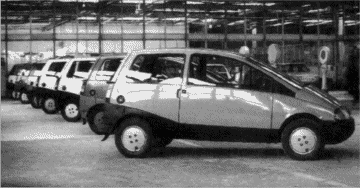In the early eighties, after some years of producing the FIAT 126p (the Polish version of the 126) under license, the Polish small car maker FSM (Fabryka Samochodow Malolitrazowych, which translates to low-capacity car factory) decided to investigate the possibility of replacing the out-dated little automobile with a more modern one. The highly capable BOSMAL Automotive Research and Developement Center (Osrodek Badawczo-Rozwojowy Samochodów Malolitrazowych), founded in 1972 and having closely colaborated with FSM on several occasions (it seems that FSM controlled Bosmal in the seventies and eighties), was charged with designing and building prototypes of the new vehicle and adapting it to the production facilities.
In 1981 the design team, led by engineer Wieslaw Wiatrak, began work on the Beskid 106, as it would eventually be called, and by 1982 the design blue-prints were completed. Following this, developement, such as model building, commenced and the construction of the first prototype got under way. Spring, nineteen-eighty-three, marks the completion of that first prototype and its presentation. As far as the name Beskid goes, it comes from a mountain range which passes near the city of Bielsko-Biala, where both Bosmal and the FSM factory were located.

The most startling feature of the Beskid 106, and certainly the first to be noticed, is its very pretty and aerodynamic body design. Penned by Krzysztof Meissner of the Warsaw Academy of Fine Arts, and carefully wind-tunnel tested, it has a low drag coefficient (Cx) of 0.29 and a frontal area of 1.71 m². To help acheive this reduced drag - important in reducing fuel consumption, which incidentaly measured 3.9 litres per 100 km at a constant 90 km/h velocity - the under-side of the little vehicle was also designed to be smooth. As an aside, the similarily-sized Renault Twingo, introduced in the early ninetees, resembles the look of the Beskid in many ways and this explains why the Beskid has often been referred to as the "Polish Twingo".
There were actually seven or so prototypes of the Beskid, in three variations. All of them had a 2150mm wheelbase, a height of 1364mm, a 1530mm width, a ground clearance of 135mm, and a weight of slightly over 630kg. And while the third series prototypes had an extended length of 3.5 metres, the rest were 3235mm long. Brakes were drums at front and rear on the early examples, later the front received discs. The all-round independent suspension featured MacPherson struts at front and trailing arms at the rear. Most of the prototypes differed in the capacities (which ranged from 594 cc to 1116 cc) of their engines, most of which were based on the water-cooled 2-cylinder 4-stroke one powering the FIAT 126p. The 594 cc unit, utilized in the first prototype, developed 20.6 kW (27.6 hp) @ 5500 rpm, while a 703 cc variation generated 22 kW (29.5 hp) @ 5000 rpm and 49 Nm @ 2700 rpm. Any of these powerplants was enough to propel the Beskid to speeds of over 120 km/h (the FIAT 126p had a hard time reaching 100).

Under the skin, the prototype utilized many components from the FIAT 126p (such as the already mentioned power units and the tiny wheels) to minimize the cost of an eventual phasing into production. Even so, there isn't much similarity between the two, as the Beskid is a front-engined front wheel drive vehicle with enough space for four or even five adults. It is true that the trunk space of this small economy car is not huge but still of higher capacity than in the 126p, a car in to which it would be quite difficult to stuff four adults. The rear seats of the Beskid can also be folded to create a two-seater with a huge 800 litre (or even bigger in the case of the third series prototypes) trunk. Another cost-saving feature of the Beskid is that it's steel construction requires half the amount of stampings as compared to the FIAT.
The last year of Beskid developement was 1987 and unfortunately the very promising design never did make it into production. Around that time FIAT was working on the Cinquecento (500) which would enter production at FSM a few years later. Today, FSM is no more as it has became FIAT Poland. Ironically, while the 500 is quite popular, the 126 (including a variation developed by Bosmal) is still being made and masses of Poles continue to purchase it. And at least the Beskid project brought some improvements to the 126p power unit.

As far as the BOSMAL Automotive Research and Development Centre goes, it is now pretty much an independent hi-tech entity with ideas and contracts with various auto-makers. In 1991 they put their 126p Cabrio into limited production. Later, FIAT 500 pick-up and van prototypes were developed and an interesting trike-car prototype was constructed. Various other projects were also undertaken.

Thanks to the BOSMAL Automotive Research and Developement Center for supplying the photos and information about the Beskid. Additional information was extracted from a very detailed article about the car in the September 1986 issue and also June 1986 issue of the Polish magazine AUTO - Technika Motoryzacyjna. Thanks to Piotr Trzeciak for helping me find these articles.
Thank you,
Bolko Rawicz
Hi! I am a robot. I just upvoted you! I found similar content that readers might be interested in:
http://autohistories.org/beskid/index.html
Congratulations,
you just received a 11.05% upvote from @steemhq - Community Bot!
Wanna join and receive free upvotes yourself?

Vote for
steemhq.witnesson Steemit or directly on SteemConnect and join the Community Witness.This service was brought to you by SteemHQ.com